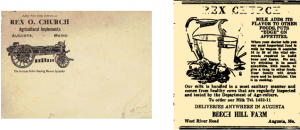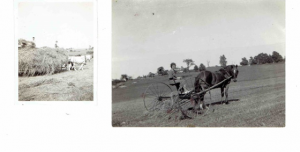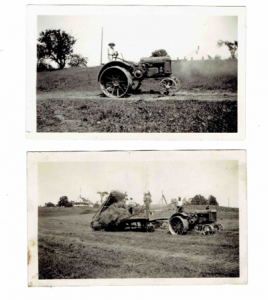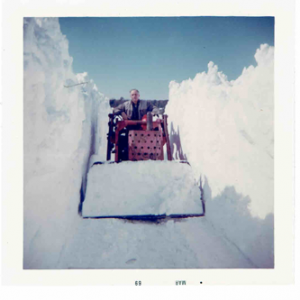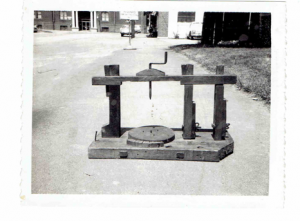Between the dawn and the daylight, while the Keurig was doing its “wackadoo wackadoo wackadoo” thing brewing my morning coffee carafe, I read an article about how climate change is affecting current agricultural practices. This was nothing new to me because I’d seen changes in some of those practices as I grew up. One aspect of researching family histories is the temptation and ability to look back and compare what was to what is. I once asked my paternal grandmother (Winifred Church, 1884–1980) how she felt about all the history she had seen in her lifetime (covered wagons and farming on the Kansas prairie to men on the moon). She just laughed and didn’t answer! But I not only live in the area where most of my family history takes place, I live in that history on the land my ancestors farmed, so I thought about the similarities and changes in our farm equipment. This was a job for the Squirrel Bins, and they quickly reminded me about all the “farm photos” I still have!
The farming methods used by my family probably hadn’t changed much between the late 18th century and the early 20th century.
The farming methods used by my family probably hadn’t changed much between the late 18th century and the early 20th century when my paternal grandfather Rex O. Church (1883–1956) ran a dairy farm and became a John Deere Agricultural Implements dealer.
Not one to abandon old ways, however, he mixed old and new technologies perhaps without considering the theories behind his methods. For instance, he and his father and grandfathers always did the haying in one field, then waited “to see what the weather would do” before moving on to hay the next field, instead of listening to the weather reports on the radio so that they could keep on “making hay while the sun shined.” Of course, they were using the old weather-prediction methods farmers used before radios arrived (watch the sky, watch the cows, watch the trees, etc.). Therefore, haying one crop on the entire farm property could take all summer in the days before automated hay balers, powerful tractors, and motorized hay loaders. It became more tradition than efficient, and they maintained that method even after they purchased the newest equipment. While my Federal Meat Inspector father worked in Boston during the week, my brother would do the haying using his ideas. The year he finished haying all the fields in two weeks had Dad spluttering in frustration with little to say against it.
Horse-drawn farm equipment was the norm for my early Maine ancestors, and even into the 1920s my grandfather would use horses as well as his Fordson tractor (it ran the saw when he cut lumber for the new barn) and later the John Deere Model D tractor with the steel wheels. The body lasted longer than the engine did; it was a “garden decoration” in the 1950s!
Perhaps snow removal techniques are the methods that have changed the most.
As they say, the more things change, the more they stay the same. Longevity runs in this family, even down to our equipment: the 1970/71 IH 444 (which replaced a 1947 Ford 8N) lasted until it was sold in 2015. Perhaps snow removal techniques are the methods that have changed the most, from the horse-drawn snow rollers to a bulldozer and current-day snowplows.
Some equipment, however, belongs to practices so long out of use that we’ve forgotten what they were for.
Some equipment, however, belongs to practices so long out of use that we’ve forgotten what they were for. The “What Is It” is a tool found in My Old House next to a very old cheese press. While it looks like some sort of drill, none of the parts move, nor does it seem they were ever meant to turn. Maybe I’ll think on that while I wackadoo another cup of coffee. . . .
Share this:

About Jan Doerr
Jan Doerr received a B.A. degree in Sociology/Secondary Education from the University of New Hampshire, and spent a long career in the legal profession while researching her family history. She has recently written and published articles for WBUR.org’s Cognoscenti blog: “Labor of Love: Preserving a 226-Year-Old Family Home and Preparing to Let It Go” and “The Value of Family Heirlooms in a Digital Age.” Jan currently lives with her attorney husband in Augusta, Maine, where she serves two Siamese cats and spends all her retirement money propping up a really old house.View all posts by Jan Doerr →
